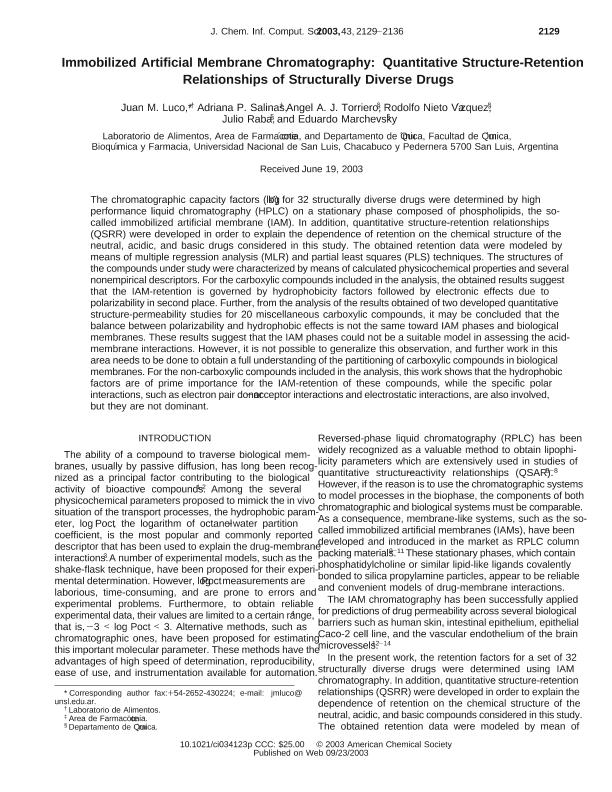Mostrar el registro sencillo del ítem
dc.contributor.author
Luco, Juan Maria

dc.contributor.author
Salinas, Adriana Paticia

dc.contributor.author
Torriero, Angel Alberto Jesus

dc.contributor.author
Vázquez, Rodolfo Nieto
dc.contributor.author
Raba, Julio

dc.contributor.author
Marchevsky, Eduardo Jorge

dc.date.available
2020-03-17T00:39:27Z
dc.date.issued
2003-11
dc.identifier.citation
Luco, Juan Maria; Salinas, Adriana Paticia; Torriero, Angel Alberto Jesus; Vázquez, Rodolfo Nieto; Raba, Julio; et al.; Immobilized Artificial Membrane Chromatography: Quantitative Structure-Retention Relationships of Structurally Diverse Drugs; American Chemical Society; Journal Of Chemical Information And Computer Sciences; 43; 6; 11-2003; 2129-2136
dc.identifier.issn
0095-2338
dc.identifier.uri
http://hdl.handle.net/11336/99759
dc.description.abstract
The Chromatographic capacity factors (log k′) for 32 structurally diverse drugs were determined by high performance liquid chromatography (HPLC) on a stationary phase composed of phospholipids, the socalled immobilized artificial membrane (IAM). In addition, quantitative structure-retention relationships (QSRR) were developed in order to explain the dependence of retention on the chemical structure of the neutral, acidic, and basic drugs considered in this study. The obtained retention data were modeled by means of multiple regression analysis (MLR) and partial least squares (PLS) techniques. The structures of the compounds under study were characterized by means of calculated physicochemical properties and several nonempirical descriptors. For the carboxylic compounds included in the analysis, the obtained results suggest that the IAM-retention is governed by hydrophobicity factors followed by electronic effects due to polarizability in second place. Further, from the analysis of the results obtained of two developed quantitative structure-permeability studies for 20 miscellaneous carboxylic compounds, it may be concluded that the balance between polarizability and hydrophobic effects is not the same toward IAM phases and biological membranes. These results suggest that the IAM phases could not be a suitable model in assessing the acid-membrane interactions. However, it is not possible to generalize this observation, and further work in this area needs to be done to obtain a full understanding of the partitioning of carboxylic compounds in biological membranes. For the non-carboxylic compounds included in the analysis, this work shows that the hydrophobic factors are of prime importance for the IAM-retention of these compounds, while the specific polar interactions, such as electron pair donor-acceptor interactions and electrostatic interactions, are also involved, but they are not dominant.
dc.format
application/pdf
dc.language.iso
eng
dc.publisher
American Chemical Society

dc.rights
info:eu-repo/semantics/openAccess
dc.rights.uri
https://creativecommons.org/licenses/by-nc-sa/2.5/ar/
dc.subject
Instrumental
dc.subject
HPLC Procedure
dc.subject
Molecular Descriptors
dc.subject.classification
Otras Ciencias Químicas

dc.subject.classification
Ciencias Químicas

dc.subject.classification
CIENCIAS NATURALES Y EXACTAS

dc.subject.classification
Química Analítica

dc.subject.classification
Ciencias Químicas

dc.subject.classification
CIENCIAS NATURALES Y EXACTAS

dc.title
Immobilized Artificial Membrane Chromatography: Quantitative Structure-Retention Relationships of Structurally Diverse Drugs
dc.type
info:eu-repo/semantics/article
dc.type
info:ar-repo/semantics/artículo
dc.type
info:eu-repo/semantics/publishedVersion
dc.date.updated
2020-02-13T20:05:46Z
dc.journal.volume
43
dc.journal.number
6
dc.journal.pagination
2129-2136
dc.journal.pais
Estados Unidos

dc.journal.ciudad
Washington DC
dc.description.fil
Fil: Luco, Juan Maria. Consejo Nacional de Investigaciones Científicas y Técnicas. Centro Científico Tecnológico Conicet - San Luis. Instituto de Química de San Luis. Universidad Nacional de San Luis. Facultad de Química, Bioquímica y Farmacia. Instituto de Química de San Luis; Argentina
dc.description.fil
Fil: Salinas, Adriana Paticia. Universidad Nacional de San Luis; Argentina
dc.description.fil
Fil: Torriero, Angel Alberto Jesus. Universidad Nacional de San Luis; Argentina. Consejo Nacional de Investigaciones Científicas y Técnicas. Centro Científico Tecnológico Conicet - San Luis; Argentina
dc.description.fil
Fil: Vázquez, Rodolfo Nieto. Consejo Nacional de Investigaciones Científicas y Técnicas. Centro Científico Tecnológico Conicet - San Luis. Instituto de Química de San Luis. Universidad Nacional de San Luis. Facultad de Química, Bioquímica y Farmacia. Instituto de Química de San Luis; Argentina
dc.description.fil
Fil: Raba, Julio. Consejo Nacional de Investigaciones Científicas y Técnicas. Centro Científico Tecnológico Conicet - San Luis. Instituto de Química de San Luis. Universidad Nacional de San Luis. Facultad de Química, Bioquímica y Farmacia. Instituto de Química de San Luis; Argentina
dc.description.fil
Fil: Marchevsky, Eduardo Jorge. Consejo Nacional de Investigaciones Científicas y Técnicas. Centro Científico Tecnológico Conicet - San Luis. Instituto de Química de San Luis. Universidad Nacional de San Luis. Facultad de Química, Bioquímica y Farmacia. Instituto de Química de San Luis; Argentina
dc.journal.title
Journal Of Chemical Information And Computer Sciences

dc.relation.alternativeid
info:eu-repo/semantics/altIdentifier/doi/https://doi.org/10.1021/ci034123p
dc.relation.alternativeid
info:eu-repo/semantics/altIdentifier/url/https://pubs.acs.org/doi/10.1021/ci034123p
Archivos asociados
